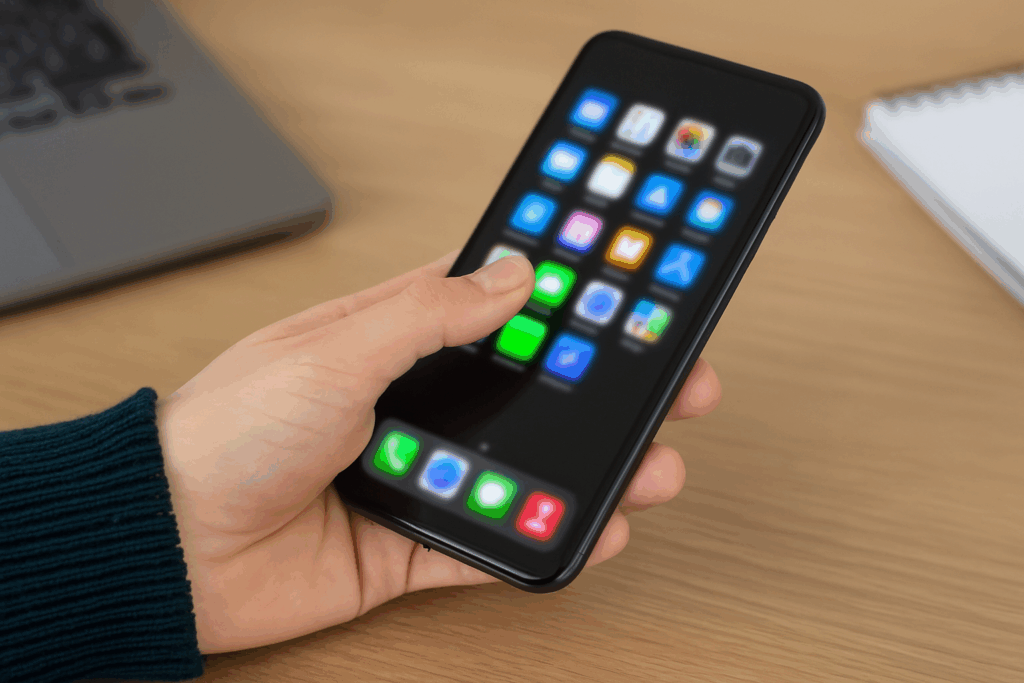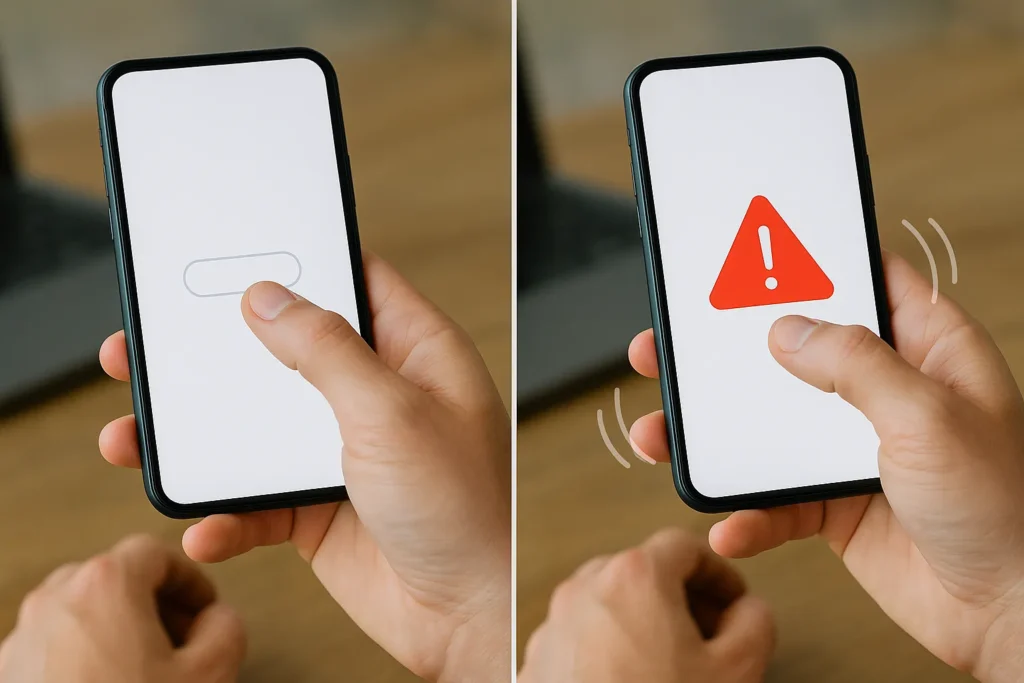
There’s a strange emptiness to digital interactions. Tap, swipe, scroll. But when your phone buzzes or a controller vibrates, it breaks the monotony (sometimes even giving you a little jolt back to reality). That’s haptic feedback, and it’s exactly where digital touch brings a meaningful shift in experience.
The subtle pulse of a smartwatch, or the gentle resistance you feel in a gaming trigger, helps create a more natural interaction. It’s all part of tactile UX, a way our devices “talk” to us through touch, helping us feel like we’re not just tapping on glass, but actually having a real interaction.
So, what’s behind these physical cues? And how are they reshaping the way we interact with the digital world? Let’s explore the mechanics and momentum behind this rising design frontier.
Haptic feedback refers to the use of mechanical signals like vibration or pressure to simulate the sense of touch. It brings a physical dimension to otherwise visual or audio-driven digital interactions. This makes the experience more immersive and intuitive.
These tactile signals are already part of daily life, though often in subtle ways. You may not think about them, but they quietly improve how you interact with technology. Consider these familiar examples:
These feedback patterns are carefully designed to match both the function and the context. When implemented well, they support users without adding clutter to the interface. And this is where tactile UX steps in.
Tactile UX or Tactile User Experience is the design process of using haptic feedback as part of the overall user experience. While once considered optional, it is now increasingly viewed as essential. Tactile UX allows designers to:
Let’s now look behind the scenes. Learning how haptic systems actually work helps explain why they’re so effective, even when the sensation is subtle.
How Haptic Systems Work: The Science of Feel
So what’s behind that satisfying buzz or tap? Most haptic systems rely on small motors or actuators that are precisely programmed to respond with physical feedback when you interact with a device.
There are a few types you’ve probably felt:
These are among the most common types of haptic actuators. They use a small off-centre weight attached to a motor shaft. When the motor spins, it causes the device to vibrate. ERMs are simple and cost-effective, which is why they’ve been widely used in older mobile phones such as the classic Nokia models, where they provided vibration alerts and keypad feedback.
LRAs offer faster and more consistent feedback than ERMs. They use a magnetic mass attached to a spring, which vibrates at a fixed frequency when electrical current is applied. This type of actuator is found in most modern smartphones and smartwatches. For example, when you feel a precise tap from your iPhone after unlocking with Face ID or a gentle buzz from your fitness tracker reminding you to move, that’s LRA in action.
These actuators rely on materials that expand or contract when voltage is applied, allowing for very precise, high-speed feedback. They are highly efficient and well-suited for touchscreens and interactive surfaces. You’ll find piezo actuators in premium VR controllers and in haptic-enabled laptop trackpads, such as those on MacBooks, where they simulate the feeling of a physical click.
VCAs work like miniature loudspeakers, using an electromagnetic coil that moves to create smooth, complex vibration patterns. These are ideal for delivering rich, detailed tactile feedback. For example, in the PlayStation DualSense controller, VCAs help simulate different surfaces and forces, like the resistance of pulling a trigger or the rumble of driving over rough terrain.
The process is instant. You touch the screen. A sensor detects it. The system processes your action and the actuator responds with a buzz or tap. All this happens in milliseconds, just enough to feel natural.
Think about the last time your phone vibrated to confirm a payment. That subtle feedback made the action feel complete, didn’t it? Or maybe your fitness tracker nudged your wrist without making a sound. These moments matter. They reduce doubt, add confidence, and help you stay focused.
This technology is catching on fast. The global market for haptic devices hit $4.78 billion in 2023 and is growing by over 16.4 percent each year.
But how is this technology really being applied in the real world? With the basics of haptics covered, it’s time to answer that question and why so many industries are embracing it.
While haptics might seem futuristic, it is already present in many of the tools and devices people use every day.
What started as basic phone buzzes has grown into a powerful design tool. It’s now being used across industries, from gaming to healthcare, to create more immersive and responsive digital experiences that feel intuitive and meaningful.

Here are some of the most impactful and creative ways haptic technology is being used today:
Tactile UX is designed to support, not distract. It makes devices easier to use by improving focus, offering feedback, and reinforcing a sense of control.
But the real shift is happening at the design level. More and more, product teams are asking: how can we make devices feel better to use? For that, let’s head into the next section.
Most user interfaces are built around what we see and hear. But what about what we feel? With haptic feedback, devices can guide, confirm, or alert through subtle physical cues. A small buzz can do what a flashing screen or loud beep can’t: give you a response that feels immediate and natural.

Here’s how it’s helping:
This is especially useful when screens or sounds aren’t ideal. Have you ever second-guessed whether a button press registered? A quick pulse can answer that question without breaking your attention. These tactile cues help users stay present and focused, even in fast-paced or hands-free environments, whether they’re cycling, checking out at a store, or navigating on the go.
But it’s not just about convenience. For someone who is blind, a long press followed by a soft vibration can confirm that a voice command was received. For someone who is hard of hearing, a smartwatch can buzz when a timer is up or when it’s time to stand and stretch. These features expand usability to more people, in more situations, without adding complexity.
Touch can also build trust. When you send a message on your phone and it gives a short vibration in response, it’s a small moment of confirmation that you know it went through. Over time, these interactions add up. Devices that respond with thoughtful, consistent feedback feel more responsive, and more personal.
For example, some meditation apps use slow, rhythmic vibrations to guide your breathing, creating a calming, almost human interaction that visuals alone can’t deliver.
Yet despite all this value, touch remains one of the most underused elements in UX design. It’s often bolted on late or ignored entirely. That’s a mistake. As interfaces become more voice-controlled, screenless, or immersive, haptic feedback will move from a bonus to a necessity.
But bringing that power to life isn’t always simple. Let’s look at what’s standing in the way and how to design around it.
While haptic feedback offers clear benefits for user experience, actually putting it into practice can be difficult. Many teams love the idea of adding touch, but struggle when it comes time to build.
From hardware constraints to software limitations, these are real reasons why haptics often get left behind:
To start, haptics require physical components. Devices need actuators, sensors, and power sources to deliver meaningful touch feedback. That can be hard to manage, especially in compact or battery-sensitive products like wearables.
This becomes a trade-off. A more powerful actuator might give better feedback, but it could take up space, consume more energy, or generate unwanted heat. Developers also have to spend time fine-tuning feedback so it feels natural. Without that effort, even the most expensive hardware won’t deliver a good experience.
Hardware is only one part of the challenge. There’s also the matter of cost. High-quality haptic components can drive up manufacturing budgets, making them hard to justify for lower-cost products.
Even when the hardware is in place, the software may not be ready. Some platforms still offer limited tools for building or testing haptic feedback. Without reliable libraries or clear documentation, developers can find themselves guessing instead of designing with intention.
Another hurdle is perception. Haptic feedback is subtle by nature, and that can make it difficult to explain to stakeholders. If a team member can’t immediately feel the difference, they may question the time and money involved.
This often results in haptics being deprioritised or removed entirely. That’s unfortunate, because when it’s done well, touch feedback solves real user problems and improves engagement in ways that visuals and sound alone cannot.
Finally, there’s the issue of poor implementation. Not all haptics improve the experience. If feedback feels random, inconsistent, or too strong, it can annoy users instead of helping them.
But getting that precision takes planning. Haptics need to match the action, the context, and the user’s expectations. When they do, they feel invisible in the best way.
So what does good haptic design actually look like?
Thoughtful haptic design is really about respecting the user’s attention. It confirms actions, guides attention, and supports users in a way that feels natural. But when it is poorly implemented (too weak, too aggressive, or inconsistent), it undermines the experience and creates unnecessary friction.

This is why thoughtful tactile UX is critical. The goal is to use touch in a way that supports what the user’s already doing, without distracting or overwhelming them.
Here are some best practices that can guide thoughtful and effective haptic design:
Effective haptic design begins with a simple question: what should the user feel, and why? Every touch signal should serve a clear purpose. Is the goal to confirm a completed action? To indicate an error? To guide movement?
Designing around user intent, rather than hardware capability, helps create feedback that is intuitive and meaningful. This shift in thinking ensures the haptics support the experience, rather than distracting from it.
Haptic feedback should match the situation it’s used in. A subtle vibration can confirm a tap in a quiet app. A stronger, more distinct pattern might be appropriate for a warning or urgent alert.
Designers must consider where, when, and how the feedback is felt. For example, the gentle nudge from a smartwatch in a meeting is useful, while immersive force feedback in a VR game enhances realism. Context informs tone, intensity, and timing, and ignoring it can lead to disjointed or confusing experiences.
Too many patterns can overwhelm users. Instead, define a limited set of haptic responses and apply them consistently. Over time, users will learn what each pattern means and respond with greater confidence and speed.
Consistency also reduces cognitive load. Just as icons and colours are standardised in good visual design, haptics benefit from predictability.
No amount of planning replaces real-world testing. Letting users experience the feedback and describe how it feels offers essential insights. Are the signals clear? Are they easy to notice but not disruptive? Do they feel appropriate for the action?
Usability testing with a diverse group ensures the haptics make sense across a range of users and use cases. It also helps uncover unintended effects early in the process.
Today, many platforms support haptic design with robust development tools:
Using native tools ensures better compatibility, smoother performance, and access to platform-specific features that make feedback feel polished and reliable.
Designing haptics with care takes effort, but when it’s done right, it makes all the difference. As more devices and platforms start embracing tactile feedback, the question is how far we can take it.
So what does the future hold for digital touch? Let’s take a look at where haptics is heading next.
Haptic feedback is quickly becoming a vital part of how we interact and communicate with digital products.
In spatial computing and AR, touch will guide users through invisible interfaces where screens may not exist.
We’re also seeing growth in emotional UX, where haptics help convey tone, urgency, or reassurance.
The next step is adaptive feedback, where systems respond in real time to user behaviour, context, or physical state. Emotional cues will then personalize the experience based on how users move and react.
Touch is fast becoming a design essential. Those who adopt it now will set the standard for more natural, responsive, human-focused interfaces.